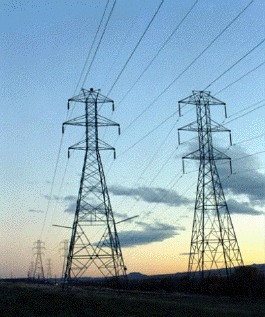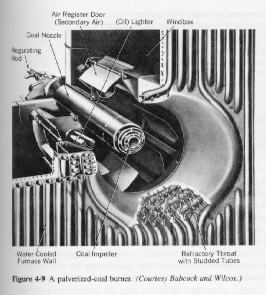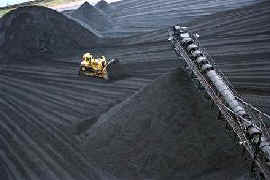|






|
Coal
Power Plant Cleans Up Its Act
RAMFORD REGISTER
3/17/02
By Edison R. Menlow
CASTLETON, Ramford County. - A few miles west of Byers Point on the
shores of the Ramford River, in an area called Castleton, the land looks deserted.
Turtles snap their jaws at small insects along the bank; a hawk circles overhead; and cows
lay low in nearby fields. It's an unlikely place for a revolution, but
on the edge of this wetland habitat IECG is close to making clean-coal technology a reality.
The 1870-megawatt Castleton plant isn't much to look at. It hides its
power well. Providing electricity for about 50,000 nearby homes and most
of Ramford's industrial base, it has the feel of a giant erector set: all twisting pipes and rough welds.
But what goes on here - a process in which coal is cooked and turned into a
gas instead of burned to create steam - could change the future of coal power generation as we know it.
"Clean-coal technology doesn't need to be an oxymoron," says Art
Clinker, an engineer at CRPF (Castleton on Ramford Power Facility), one of
only a handful of plants in the USA making gasification viable.
"When this plant was built in the
'50s, it was coal fired. Later we went to oil, and then back to coal as
oil prices rose. We've kept up with the technology in keeping our
environment clean. We have always worked to be a good neighbor to the
river.
Folks have complained for years about
the smoke from our stacks, now they have nothing more to complain
about."
Referencing the entire plant in one sweep of his arm, Clinker continued,
"By the time we're done here, we'll have uses for just about all the byproducts; we'll be efficient; and we'll offer an environmentally safe
alternative to natural gas."
Whether that's actually possible is open to debate. In the late 1970s, utility companies began switching from coal to
oil and natural gas, which were
plentiful, more efficient and environmentally benign. When the price of oil shot up to $10 per million Btu from $2.50 at the time of the
conversion to oil, this utility company started looking for alternatives. Coal, plentiful and relatively
inexpensive, suddenly found itself at the head of the energy table.
There are certain truths about coal. Today it accounts for more than 50% of
the power generation in the USA. But because it spews toxins, coal has been
long viewed as the scourge of the power industry. America's traditional
coal-powered plants pump 2.3 billion tons of carbon dioxide into the air
each year - twice the amount cars produce. In 1999, the latest year for which figures are available, coal-fired utilities filled the air with 18
million tons of sulfur dioxide and nitrogen oxide, two major components of
acid rain.
At traditional coal-fired utilities, huge iron-encased turbines pulverize
coal dust and pump it into a burner at tremendous pressure. The coal then
heats water and produces steam that spins a turbine. That, in turn, produces
electricity. That burning of coal is not only inefficient, but it is also
dirty and adds to greenhouse emissions.
CRPF's gasification process turns coal into a gas and strips out the impurities before the emissions go into the atmosphere.
"See that," Clinker says, pointing to the seeming nothingness pouring out of
CRPF's three stacks. "Someone can be sitting near a coal gasification plant and see
nothing coming out of it. That's the goal." (In actuality, the clouds pouring from traditional plants are water vapor. It's the invisible gases,
like sulfur dioxide and carbon dioxide, that are greenhouse gases.
Clinker
admitted that carbon dioxide was spewing from the CRPF stacks, but you couldn't see it.)
Even so, compared with a typical coal-fired plant with modern pollution control devices,
CRPF produces 85% less nitrogen oxide and 32% less sulfur dioxide, according to
International Electric, the plant's corporate parent. Environmentalists are quick to point
out that's still 20-times more nitrogen oxide than a natural gas fired plant
and 100 times more sulfur. Natural gas emits virtually no sulfur.
Environmentalists say clean-coal technology is too little, too late. "This
is all well and good, but they should have done this when they converted
back to coal," says Gray Ashford, energy specialist at the Planet Resources Institute, a
Washington, DC-based think tank. "Federal money would be better spent on renewable energies," he says.
Sir Kurt Breaker (formerly of the UK and past Energy Minister for
Lancastershire Uplands, and now energy specialist at the Global Resources Defense Council,
agrees. "The concern isn't so much whether clean-coal technology works, the
big question now is whether they are robbing a variety of other technologies
to make clean coal viable."
CRPF is building on research that began in the 1980s, when coal plants were
shown to contribute to acid rain. In 1990, Congress amended the Clean Air
Act, phasing in tighter limits on emissions of soot particles, nitrogen oxides and sulfur dioxide. To help utilities come in under the more
stringent rules, the Department of Energy spent $1.8 billion on clean-coal
tech programs. CRPF is one of them.
Recently, most research has zeroed in on the development of super-efficient
burning methods so that plants can extract more electricity from less coal.
The average pound of coal contains about 10,000 Btu. Most coal-fired plants
capture about a third. Newer ones like the facility in Ramford County facility can extract
37%, and Ashford sees that rising to 40% within 10 years. The Energy Department has set an efficiency goal of 60% by 2025.
The gasification of coal requires a maze of chemical processes. The coal
first has to be ground up and mixed with water to create a slurry that is
the consistency of a good mud pie. A huge whirling drum with big teeth grinds down 2,000 tons of coal at
CRPF every day. Oxygen and the coal slurry are forced into a tall gasifer and they react about 2,400 degrees Fahrenheit
to form a synthetic gas.
Looking at Castleton on Ramford, it is easy to jump to the conclusion that clean-coal
technology may have actually arrived. But there is a catch. Construction
costs for conversion to gasification plants can be twice as much as those for standard
coal plants. The cost of producing energy is higher, too. The best gasification plants produce electricity for about $1,200 per kilowatt. Coal
pulverization plants produce at about $700 per kilowatt and natural gas,
about $1,000 per kilowatt. Ashford says the costs will come down over time, and the volatility of natural
gas prices makes gasification of coal a necessity for utilities hedging against higher prices. The challenge is convincing the power industry that
gasification plants are worth the expense.
The Bush administration may have a big say in whether that happens. A tiny
section of the Clean Air Act called the New Source Review prohibits power-plant operators from expanding old plants without installing
state-of-the-air pollution control devices. Utilities have said that the
Clinton administration's strict interpretation of the New Source provisions
stifled innovation and efficiency and are partly to blame for recent power
shortages. If the regulations are upheld, it could give utilities an incentive
to upgrade traditional plants with gasification facilities.
Gasification could also be an important part of the White House's new global
warming policy. After President Bush pulled back from the Kyoto Protocol to
combat carbon dioxide emissions, he ordered his Cabinet to draft an alternative that would appease European allies. Gasification could play a
big part in that plan.
Of all the energy sources, coal is the least expensive and most plentiful.
Worldwide use of coal for power generation is expected to double to 50% by
2015, according to Department of Energy figures. The Bush administration
proposed budget for fiscal 2002 sets aside $211 million for clean-coal programs - that's triple the amount from this year.
"You just need a little faith in the technology and in our ability to solve
these problems as they come up," says Clinker, surveying the plant. "Clean-coal technology is not only possible, we're
doing it."
|






